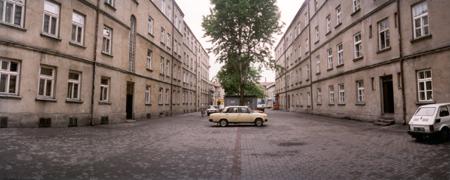
Pierwszy Aleja No. 8
Joseph Sher and his family lived at this address on the third floor, left side. The ground floor front of the apartment house was a shop that faced the main street of Czestochowa. The street follows the pilgrimage route to the Church of the Jasna Gora, the Black MadonnaBlack Madonna: the popular shrine of great national and religious significance to Poland. It is located in the city of Czestochowa in the monastery of Jasna Gora (Bright Mountain). The Black Madonna is a painting on wood that depicts the Virgin Mary and baby Jesus. Its origins are ancient and obscure.
The monastery was founded on the mountain in 1382, and the painting came there soon afterwards. The icon was damaged in 1430 by Hussites who slashed the face of the portrait. The painting is credited with the miracle of having protected the monastery from the invading Swedish army in 1655-56. The shrine continues to be the focus of pilgrimages and a site for confirmations and marriages. Source: Dydynski, Poland, Lonely Planet Travel Survival Guide. . When the Jews were forced into the Czestochowa ghettoCzestochowa Ghetto: established on April 9, 1941, it was sealed off on August 23, 1941. The ghetto population suffered from overcrowding, hunger and epidemics. On September 23, 1942 a large scale deportation (Aktion) began. By October 5, 1942, about 39,000 people had been deported to Treblinka extermination camp, while 2,000 had been executed on the spot.
The now diminished ghetto within new borders was called the “small ghetto.” A Jewish Fighting Organization was set up in December 1942. On January 4, 1943 it rose in armed resistance to the Nazis. The next day the Nazis shot 250 children and old people.
On June 26, 1943, the Germans began liquidating the “small ghetto.” The remaining 4,000 Jews were transferred to two slave labor camps organized at the city’s HASAG factories. Before leaving the city on January 17, 1945, the Germans managed to deport almost 6,000 inmates from the HASAG factories to concentration camps inside Germany. The 5,200 inmates who succeeded in hiding were liberated by the Soviet army.Source: Encyclopedia of the Holocaust. , other families moved into the vacated apartments. Discarded items, including family photographs, were thrown down in a heap in the center of the courtyard. After the war ended Joseph Sher dug with his hands through the rotting heap of garbage. Several layers down, untouched by water or mildew, were his treasured family photographs.
Photo Credit: John Menszer